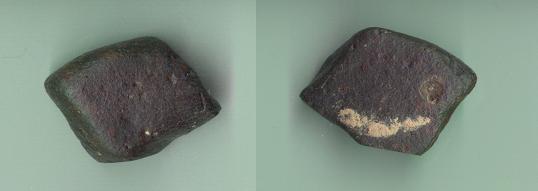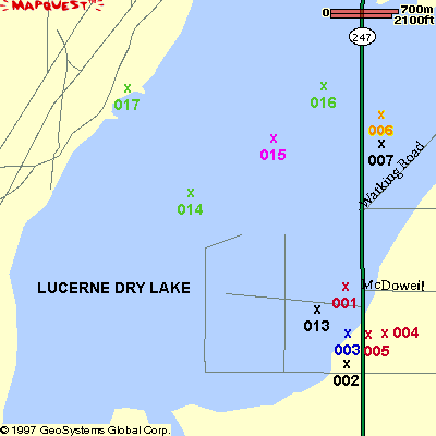




- - - -
"UPDATE" - [circa 2011] - - - -
- - - - ALTHOUGH MY WEBSITE (BELOW) IS MORE THAN 10 YEARS OLD - - - -
- - - - IT IS STILL A GOOD HISTORICAL ACCOUNTING OF THE FIRST 17 LUCERNE VALLEY METEORITES - - - -
- - - - SINCE THAT TIME THERE HAVE BEEN MORE THAN 100 MORE METEORITES FOUND - - - -
- - - - TO SEE A LIST OF ALL "REPORTED" LUCERNE VALLEY METEORITES, CLICK HERE - - - -
 |
Field Work 1998 |  |
Base Camp |  |
Meteorite Hunt |  |
New Finds |  |
Map |
The original purpose of this web page was to determine, if after 30 years, whether it can be resolved that the meteorites at Lucerne Dry Lake are members of a single strewnfield, or are multiple, overlapping falls. During the 1998-1999 field effort, 4 additional chondrites were recovered. Subsequent analysis has shown that of the 17 known chondritic stones, 9 (nine) of them are uniquely different. What was formerly considered to be 17 members of a solitary fall event, is now known to be groups of stones from at least 9 separate falls, and are now known, collectively, as the "Lucerne Valley Meteorites".
Field work between September
and November 1998 has resulted in 3 new finds by this writer. These
finds have been donated to the Griffith Observatory and join the 5
other specimens that are on display. Sections have been taken from
these specimens and have been characterized and paired at UCLA by Alan
Rubin. Since then, samples have been taken from the other "LV" finds
(16 of the 17), and these have been characterized and paired by Alan
Rubin, as well. Through the generosity of all the finders and holders
of "Lucerne Valley Meteorites", it has been determined that "no fewer
than nine (9) separate falls" have occurred at Lucerne Dry Lake! This
has brought about a re-evaluation of pairings based solely on
proximity. Although the ratio of "# of falls to total # of finds" is
the highest yet known, it still only corroborates the generally
accepted "average meteorite flux density" of ~1 fragment for every sq.
kilometer.
If additional "LV" finds are made, they will be posted here:
-
"UPDATE" - [circa 2001]
- - [dated] INFORMATION - -
My
TABLE of Lucerne Valley Meteorites - with IMAGES, is the
most current listing (has LV 013 reclassified and paired to LV 015
& LV 016) and is available to those whose browsers aren't setup to
handle the MAPS ".pdf" files, just by "clicking"
HERE
Our
ABSTRACT on the Pairing of L.V. Meteorites, has finally been
published in the LPI Contribution No.997, for the "Workshop on
Extraterrestrial Materials From Hot and Cold Deserts", July 6-8, 1999
Kwa-Maritane, Pilanesberg, South Africa, but the pre-review version is
still viewable just by "clicking"
HERE
TABLE
4: Meteorites from Lucerne Valley, California, as published
in Meteoritical Bulletin, No.83
This "Table 4" has been
subsequently revised (classifications for LV 002 & LV 017) and is
reflected in Meteoritical Bulletin, No.84
The most recent paper relating to the pairing of Lucerne Valley
meteorites can be found in "Numerous unpaired
meteorites exposed on a deflating playa lake at Lucerne Valley,
California", RUBIN, A. E., 2000, Metorit.
Planet. Sci.(MAPS) 35 (Suppl.), A181-A183
- - - REFERENCES: - - -
- - THE FOLLOWING ARE FROM THE "Meteoritical Bulletin", THE "Catalogue
of Meteorites", and "The Griffith Observer" - -
Catalogue of Meteorites - Lucerne Valley - a photocopy of the paragraph as it appears in the "Catalogue of Meteorites" (Blue-book version) in which the following phrase "Meteoritics, 1964, 2, p.177, Meteor. Bull., 1964 (29)" appears to give credit of authorship to J.D. Buddhue, but, as I've shown above, the "preliminary report" on "p. 177" is actually authored by RONALD N. HARTMAN and RONALD A. ORITI. A document search for a paper by J.D. Buddhue netted no results. The only other reference to this meteorite was published in RUSSIAN and only the names "R.N. Hartman, R.A. Oriti, and R.W. Leonard" appeared in that report.
The Lucerne Valley Aerolites - a reprint of the November 1965 "Griffith Observer" article by Ron Oriti.
Dry Lakes and Meteorites - a reprint of the November 1965 "Griffith Observer" article by Ron Oriti.
Lucerne Dry Lake "Revisited" - a reprint of the December 1968 "Griffith Observer" article by Ron Oriti.
 |
|---|
| Lucerne Valley 014, Stone, Ordinary Chondrite (L5), 3.4 grams Found Sept. 26, 1998 on Lucerne Dry Lake by Beth and Bob Verish and their pet dog Melvyn |
 |
| Lucerne Valley 015, Stone, Ordinary Chondrite (LL6), 12.5
grams Found Oct. 25, 1998 on Lucerne Dry Lake by Bob Verish Note rough exterior on this flanged/oriented individual. This is the first reported LL6 (formerly called "amphoterite") found in California. "Click" on thumbnail image for more information. |
 |
| Lucerne Valley 016, Stone, Ordinary Chondrite (L5), ~3.5 grams Found Nov. 14, 1998 on Lucerne Dry Lake by Bob Verish Note smooth exterior. Paired with my other L5, per A. Rubin. |
- - - ALMOST 36 YEARS AFTER MAKING THE
FIRST LV METEORITE FIND, - - -
|
 |
| Lucerne Valley 017, Stone, Ordinary Chondrite (L6 S3 W4),
12.8 grams Found March 30, 1999 on Lucerne Dry Lake by Ron Hartman Note smooth exterior and rhombohedral shape. NOT PAIRED with any other LV find, per A. Rubin. |

|
| "Click" on the above image in order to see a map of where Ron's LV 017 was found! |
|
-
"UPDATE" - [circa 2010] - - - VARIOUS OTHER METEORITE HUNTERS CONTINUE TO FIND MANY MORE LUCERNE VALLEY CHONDRITES - - - - - - AS OF 2010 OCTOBER 10TH THE NUMBER OF LUCERNE VALLEY METEORITES "REPORTED" IS : 121 |
| "Click" on the above image in order to get the ENTIRE LIST of LUCERNE VALLEY METEORITES |
These 121 meteorites represent 12 separate falls over geologic time upon the Lucerne Dry Lake surface (per Dr. Alan Rubin, UCLA) and given its area of 12 square kilometers, this is the highest number of falls per unit area on record (effectively, 1 fall per square km).
|
This website is dedicated to my mentor, Ron Hartman (1935-2011) |
A LOT of visits since October 7, 1998. |
| Home Page Maintenance by Bolide*chaser |
Previous Update: February 28, 2001
Last Updated: October 10, 2010